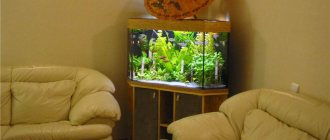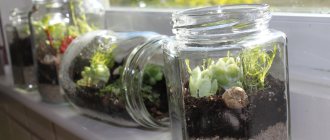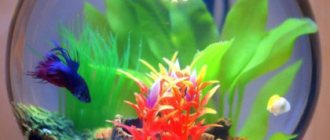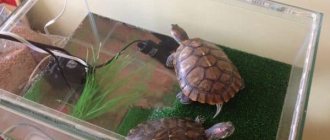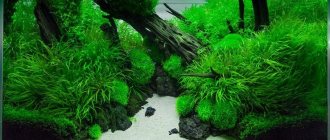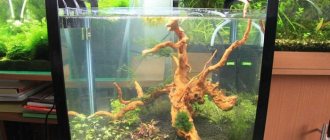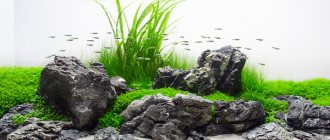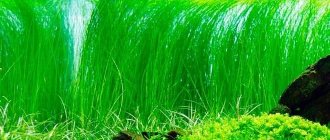The decoration of the aquarium should be absolutely natural in order to create the most comfortable conditions for the fish. An aquarium should be a piece of nature, a pleasant piece of furniture for our eyes, but a particularly suitable habitat for the benefit of fish. When purchasing each design element, you must carefully consider your decision. Consider ready-made options for decorating an enchanting aquarium.
Styles
Today, there are several very interesting and common stylistic solutions for aquarium design that allow you to create a unique and inimitable composition inside a glass structure.
For initial experiments, small aquariums with a volume of 20, 30, 40 liters will do.
If you have at least minimal experience in creating aquarium design, you can begin to decorate larger volumes, at least 50 or 60 liters. But in large glass structures of 200 liters or more, it will be possible to construct an entire underwater town with multiple decorative elements.
The aesthetics of the house are not important to fish; the main thing is that the composition includes secluded corners where the scaly creatures can hide.
You should familiarize yourself with the most common aquarium styles.
Dutch
The history of this style begins in the 50s of the last century and since then has been widely popular in the world of aquascapers. The main characteristic of the Dutch stylization of aquariums is densely planted plants and densely arranged decorative elements that occupy almost all the available space.
This is especially true for the lower part of the aquarium.
Upon visual inspection, there should be no empty areas at the bottom of the exposure. For this reason, it is necessary to plant a large number of plants of different sizes, among which a contrasting combination of red and green shades is welcome.
The middle of the aquarium should be decorated with driftwood arranged together or a structure made of large stones.
Natural
When using this style, it is important for aquascapers to emphasize the maximum interconnection of natural elements. The composition can use a variety of elements, for example, stones or driftwood.
They do not necessarily have to be placed far from each other; thanks to a creative approach, it will be possible to group natural elements in a mysterious composition that hides a secret plan.
Having chosen a variation of the iwagumi design, the aquarist will need to create an unusual composition of figurines in the form of decorative houses or ships, furnished with Japanese dwarf trees and stones.
Of particular interest when creating a natural style is the variation of wabi-kusa design. Its distinctive feature is a moss hummock located above the surface of the aquatic environment.
Pseudo-sea
The presented style of aquarium design does not require large expenses from its owner. To create a pseudo-sea environment, you will need to place regular soil on the bottom of the aquarium and plant plants that do not require special care. As a backlight, it is preferable to use lamps with blue tones, so that visually the water acquires a sea tint.
Shells are used as additional elements to emphasize the marine theme; do not forget about corals, and artificial shells will help complete the design of this beauty.
The finished composition will delight visiting guests; everyone will feel like they have actually found themselves in the depths of the sea. But in general, such aquariums are considered freshwater, so it is necessary to stock fish that are suitable for this environment.
Collector's
For most aquarists, creating a Dutch style aquarium can be a difficult job, especially for beginners. Therefore, aquascapers were able to create a simplified Dutch theme, which they called the collector style.
Its essence lies in planting small-leaved and fast-growing plants, which in a short period of time can increase in size and occupy the entire soil.
It is preferable to use the collector style in aquariums with a minimum volume of 100 liters.
For glass structures with a smaller size, the collector design style is not recommended. Otherwise, the entire space will be blocked by green plantings, and fish and other creatures will have no free space to exist.
Rock garden
For most modern interiors of houses and apartments, it is very difficult to fit the usual style of aquarium design. Thus, a glass structure decorated in the Dutch style will not be able to harmoniously combine with the interior of a high-tech or loft apartment.
Japanese designers managed to find a solution to such a complex issue. They were able to compose the aesthetics of the decorations while leaving most of the underwater space unfilled.
To do this, you just need to use regular soil, sand, a few stones, carpet-type algae and a small school of small fish. In this case, stones play the most important role. It is enough to use only 4 natural elements, where 1 should be large in size and be the main one, 2 stones should be medium in size and be additional.
But the 4th stone should differ in the most minimal sizes, and it is not necessary to use real stones; they can be purchased at pet stores.
Based on fairy tales
The fairy-tale style of the aquarium is considered the most vibrant and interesting; it is especially often used when decorating aquariums in homes where small children live. The designers were inspired to develop an underwater fairy tale style after watching the famous cartoons “Nemo” and “The Little Mermaid”.
The very first fabulous composition that appeared in the aquatic environment of home aquariums received recognition from aquascapers and still occupies the top rung of the leadership ladder.
The main thing before decorating is to strictly follow the rules for creating decor. To begin, make a sketch selected from the cartoon you like, select fish that match the color and shape. As additional elements, you may need to purchase shells of bizarre shapes and different sizes, as well as grottoes, corals with neon iridescence, and artificial treasures.
Small algae, easy to care for, can highlight the beauty of the fairy-tale world.
Children will spend their free time near a fabulous aquarium with great pleasure, especially if the interior design is presented in the composition of the child’s favorite cartoon.
Unforced Herbalist
In an unformed herbalist, plants play the main role and the focus is on them. Plants grow naturally in it, without human influence, and look natural.
Boosted Herbalist
In the forced herbalist, the emphasis is also on vegetation. The inhabitants are in second place. In such a herbalist, a certain level of gases and fertilizers is maintained to create lush vegetation.
Plot
This style consists of decorating a container in the theme of a certain plot. This could be the plot of a book, film, or story.
The plot style is done through thematic figures, the creation of colors and shapes.
Vanguard
Avant-garde style is non-standard. Fits well into unusual and bright rooms. Most often artificial plants, unusual light, and brightly colored soil are used.
Biotope
The biotope style involves copying the structure of a natural body of water. This is the use of the same stones, the introduction of the same plants into the aquarium or local fish.
Combination with natural
When choosing plants, it is not at all necessary to turn only to living or only to fake plants. Various artificial decorations go well with natural types of algae. By combining them, you can create a unique design for your aquarium. Some recommend arranging decorations in such a way that there is a 50/50 ratio of natural and artificial objects in the tank, this will preserve the aesthetic appearance and also reduce the amount of hassle associated with living plants. Some people think that such a mixture will look ugly, however, they have now learned to make such reliable copies that even experienced aquarists in the water cannot distinguish which type of algae is located. Especially when a composition is made up of several living and “not quite” plants.
Fish are quite calm about such a neighborhood, herbivores will not touch plastic, and small species will quite adapt to the new shelter.
Artificial plants are an excellent replacement for aquarium algae, and in some cases they are simply necessary. After all, even for the most fastidious fish, you want to make a small, beautiful and cozy house from their empty and transparent tank.
What can be used as aquarium decor?
A properly designed indoor pond looks consistent and complete. The aquarium is the central element of the interior, so the composition should not fall outside the design of the room.
The decor must be disinfected before use.
Background
A background pattern will help to visually increase the volume of the container or complete the design. Self-adhesive film with a thematic image is often used as a base. The rear outer wall of the tank can be painted with special paints.
Volumetric plot models or underwater algae gardens are made with your own hands from available materials.
Priming
The substrate imitates the river or sea bottom and becomes the basis for the development of plants. Quartz sand has a pleasant natural shade and creates a comfortable, relaxed environment in the aquarium.
If the tank is decorated in a marine style, then the white soil made of marble chips looks luxurious.
The black basalt substrate looks unusual. The glossy surface of the bottom attracts the eye, but has a bad effect on vegetation. For garden ponds, it is better to take sand with a nutrient base.
Multi-colored bright options stain the water, which is dangerous for the health of flora and fauna.
Coral chips
For aquarium design, white voluminous decor is often used. The component looks impressive in any composition and brings a sense of wild nature to the pond. The elements are placed in a thin layer on the sand next to models, plants and driftwood.
Coral chips increase the hardness of the liquid.
Stones
A simple solution will help you quickly create a natural relief in the tank. Artificial decor is inferior in appearance to its natural counterparts. When creating a marine design, the bottom is completely covered with pebbles.
Individual large stones support plantings of greenery and focus attention on the unusual shape and color of the varieties.
Plants
Flora is a common decorative element of artificial reservoirs. Vegetation will not only provide shelter for fish, but also become a style detail. Java moss looks luxurious in the foreground of the aquarium, and bright Ludwigia repens or Vallisneria in the background.
Fast-growing groundcover species will create a green carpet on the bottom, and drifting species will create a green carpet on the surface. Varieties are chosen according to the preferences of the inhabitants and according to the design direction.
Figures
To emphasize the style, designers use small decor. Sunken ships, caves and figurines will help recreate the sea (pirate) theme. Models of grottoes or castles make original decorations and shelters for fish. You can put imitation jewelry, chests or bones at the bottom.
It is important not to go overboard with details, otherwise the pond will be visually overloaded.
Natural materials
Corals and shells will give your aquarium design a marine feel. Large, original-shaped driftwood without bark that peeks out above the surface of the water looks luxurious.
The Japanese style uses a single piece of wood that resembles a dead tree.
Artificial elements
Today there is a huge variety of artificial decorations for aquariums, among which there are both miniature plant bushes and huge background walls located inside the glass structure on the back side.
These walls may have the design of a mountain slope or an abandoned palace of an underwater king, but the image of the sunken Atlantis will look very interesting in the decorative design.
The main thing is to remember that all artificial materials must be installed in fresh aquariums; artificial decor is not suitable for marine fish.
Advantages and disadvantages of artificial flora
Many aquarists mistakenly believe that without living flora a pond will not function normally, but this is not entirely true. Living aquarium plants produce oxygen, which is so necessary for the life of many phenotypes, but in the absence of flora, an aerator and air stones are quite capable of handling this responsibility, so now owners of reservoirs are increasingly giving preference to algae made from high-quality material - polyamide. It is so harmless and environmentally friendly that blood vessels for the human body are made from it. Artificial plants for an aquarium have many advantages, among which the most significant are:
- Durability - with good care and careful handling, artificial underwater flowers can delight the owner for 6-7 years. Such a plant does not rot, it is not bothered by natural wear and tear, and, in addition, the flower is very difficult to damage.
- Easy to maintain - to maintain its beauty, the artificial aquarium plant can simply be cleaned under running water. It does not require fertilizers, fertilizing, removal of overgrown parts and creation of the necessary water levels.
- Economical - polyamide vegetation will cost much less than buying and caring for living flora. In addition, you can purchase copies of exotic and rare species, which will be no different from the real ones, and cost several times less.
- Beauty and accessibility - the choice of artificial plants is huge, and in stores you can buy a flower of any shape and color. This allows you not to limit the aquarist’s imagination and create any design of the reservoir.
- Convenience - artificial aquarium flora allows you to change the composition of the tank in a matter of time, since the plants can be moved and changed without causing damage.
- Inedibility – algae-eating fish cannot eat an aquarium artificial flower, so you don’t have to worry about the safety of the flora.
- Insensitivity – polyamide vegetation for aquariums is resistant to medications, so you can safely treat fish.
Editorial: Cuban Swordtail
However, in addition to an impressive list of advantages, artificial plants also have disadvantages:
- An aquarium with artificial plants will need to be equipped with aeration, since non-living flora is not capable of creating an ecosystem in a reservoir and.
- Plants made from non-natural silk or polyamide cannot clean aquariums of nitrates and other fish waste, so a good filter is required in the tank.
- Stagnant zones in aquariums - the occurrence of zones is inevitable, since artificial flowers do not have roots.
- Causing injury to fish - when buying cheap flowers with sharp leaves, fish may get injured on the edges. It is worth noting that high-quality flora made of silk or polyamide does not belong to such colors.
- Algae Development – Over time, tiny algae will inevitably form on a non-living plant. Getting rid of them is simple: just wash the flower using disinfectants.
Separately, mention should be made of the toxicity of the materials used to make algae. Many aquarists believe that immersing artificial plants is dangerous to the health of fish and shellfish, since toxic materials that are stained are used in production. This is true: cheap types of flora are made of harmful materials, but this does not apply to high-quality plants made of artificial silk or polyamide. Therefore, you should purchase flora for aquariums only in trusted stores, and also check the flower at home for coloring.
Decoration procedure
An experienced aquarist, without much difficulty, will be able to correctly create a composition that matches the chosen style with his own hands, having previously acquired the necessary decorative elements, plants and soil.
And all thanks to the sequence of actions, which is very important for beginning aquarium lovers to remember.
Of course, many aquascapers can share different ways of designing aquariums, and always in a different order, but it is best not to deviate from the following generally accepted canons:
- you need to understand and choose the appropriate style for decorating the aquarium world, and then develop the design yourself;
- purchase the necessary elements and decorative items;
- treat all decorative parts, even natural stones and driftwood, accordingly;
- add a primer layer to the bottom of the aquarium;
- in the case of decorating a live freshwater aquarium, pour soil over the primer layer;
- the upper part is covered with decorative soil;
- carefully arrange the processed decorative elements;
- secure the equipment, namely the compressor, thermometer, lamp, heater;
- plant plants by making a hole for them;
- carefully pour water;
- add underwater inhabitants to the aquarium;
- sea corals are placed at the very last moment after the fish are landed.
Developing an action plan
It's a good idea to come up with a plan of action. Firstly, it is always easier to act according to plan. Secondly, you will have a list of necessary decorative elements and equipment .
Thirdly, having ready-made instructions for action, it is much easier to adapt to unexpected circumstances.
Filling procedure
It doesn’t matter in what style the work on designing the reservoir will be done - in order for it to function for a long time, there are a number of general rules for starting it up:
- At the time of filling the aquarium with decor and starting the aquarium, the fish should be kept in a separate small tank, undergoing quarantine before moving in.
- All decorative elements must be disinfected so as not to become a source of infection for living organisms.
- When all the necessary equipment is installed, you need to make sure that it is in working order.
- Let the filled reservoir sit for a week to form its own microclimate, and only after that introduce inhabitants into the aquarium.
Accessories palette
Accessories for a landscape aquarium can be purchased or found on a walk, but in any case they must be properly treated before being placed in the water. The exception is decorative film.
Decorative background
The film is glued to the outside of the back wall, so it does not require preparation or safety testing. An aquarium background created by a professional designer helps create a background, perspective, and enrich the landscape with details.
Ideally, the underwater design of the aquarium flows smoothly into the background, and when this effect is achieved, the result is impressive.
The stickers use Disney stories; there are also series in Japanese and Dutch styles to help those who are decorating an aquarium with their own hands for the first time. As a rule, stickers include models of rocks and other elements of the underwater world.
You can also use a three-dimensional background attached to the wall from the inside, but you need to know what dangers it poses for small inhabitants. If the plastic background peels off from the wall of the aquarium - and this happens, sooner or later, then the fry and small fish that swim into the gap will not be able to get out of there on their own.
Models of stones and pearls
Stones, grottoes, treasure chests and corals are all made of synthetic resins and require antiseptic treatment according to the instructions before use. The finished decor is fixed to the bottom and walls of the aquarium with silicone glue, building the basis of the future composition.
Subsequently, it is supplemented with plants and inhabited by inhabitants.
Wooden driftwood
Driftwood and twigs are a fashionable decorative element. They imitate the roots of plants, the trunks of fantastic underwater trees, and the slopes of gorges. Usually they are used in the design of an aquarium not on their own, but as a platform for growing moss.
The moss is tied to a snag with fishing line or ordinary cotton thread, and it grows, forming, according to the aquarist’s plan, the crown of a tree or thickets in mysterious grottoes.
Purchased driftwood must be boiled for two hours before use. When selecting suitable samples in the forest, you must remember that resinous and tannic wood (conifers, oak) is not suitable, it will stain and acidify the water. You need dead old roots and branches that do not secrete sap and resin.
They are boiled for a long time, in several waters, until the water stops being colored. Then they boil in salt water and soak again in fresh water - all so that the wooden decor does not soften the water. The safest thing for an aquarium are whitish driftwood, rolled by the waves and thrown onto the shore of the sea or river.
As a rule, they have expressive streamlined shapes. But they must be strong enough and not rotten.
To prevent the wooden elements from floating, the composition must be secured with silicone glue.
Natural stones for aquarium
Natural minerals, of course, are more expressive than fake ones, but not every stone is suitable for an aquarium. To begin with, the found stone should be thoroughly washed and boiled, and then a drop of vinegar should be added. If the vinegar sizzles, it means that the mineral contains lime, and this is harmful to both plants and fish.
You should pay attention to granite, basalt, quartz, sandstone , and even better - buy ready-made stone elements for an aquarium in a specialized store.
Immediately before placing in the vessel, the stones are cleaned with a stiff brush and scalded with boiling water. When forming a composition, you need to take into account the preferences of the inhabitants. Shrimps look for small caves, there should be a lot of them, “to choose from.”
Cyclids prefer grottoes made of sandstone - the stones must be fastened together with silicone, otherwise large individuals will destroy their own shelter.
Homemade florarium
Making a florarium with your own hands is not that difficult. Follow the step by step instructions:
1. Sketch a sketch plan . Think over the composition from all sides, carefully selecting plants with the same care requirements.
2. Prepare a container . Clean and wash it thoroughly. Then carefully pour boiling water over it to prevent it from cracking. Wipe with alcohol.
3. Place drainage . Add charcoal to a layer of expanded clay or small stones (no more than 3 cm). It will protect against mold and fungi.
4. Add soil . Use a funnel made of folded cardboard for this. Level the surface.
5. Plant some plants . To begin, mark the places for planting, make small holes and lightly moisten them. Clean the roots and trim them carefully to slow their development .
Tip : Don't use too many plants or plant them close to each other.
6. Water the plants. If the soil is already moist, then just spray the leaves of the plants.
7. Decorate the composition. Use toys, driftwood, colored sand, mulch. For effect, add lighting, replicas of waterfalls and streams.
8. Wipe down the walls. Do this with a dry cloth inside and out. Close the container with the lid tightly.
Important: for disinfection, it is recommended to dry the soil and wash the drainage and decor in boiling water.
Various containers for mini gardens
How to choose a container for different rooms
The main rule of choice concerns the correspondence between the size of the artificial reservoir and the room in which it is planned to be installed. You cannot place a large aquarium in a small room. In this case, you can provide miniature options or objects of non-standard shape (for example, in the form of a column).
It is necessary to provide space for equipment (filter, cooler, etc.) in advance.
Consider also how well a particular model will fit into the design of the room. There are different decorating styles that may not suit any given room. If there is free space only in the window area, you should refuse to install the container in this room.
Fish and plants should not be exposed to direct sunlight as this will cause them serious harm.
Fish n Flush
0
Source:
Like the creation of a number of other pleasant things, the creation of the Fish n Flush tank aquarium took place on a whim. Engineers, working on solving the technical problems of tanks, were dealing with a transparent tank, and it dawned on someone: you can place an aquarium in it! Thus the idea of Fish n Flush was born. The invention has appeared in many television series.
×
Which room should I place the aquarium in?
It is best to place the item in a room where its dimensions allow. Most often, the living room or bedroom is chosen for this. But you may prefer other places. An artificial pond will look good in any room if you choose its shape and style correctly.
Let's consider where you can put the aquarium in the apartment so that it fits into the design.
Kitchen
A small object is usually placed in the kitchen. It will help give coziness and comfort to a room in which people spend a lot of time. If the kitchen is large and there is a separate dining area, you can install a large aquarium.
In this case, it will act as a partition, with the help of which the space is zoned.
Living room
This is a classic option for installing an artificial pond. All family members gather in the living room. The container can stand in a special niche or on a cabinet provided for it. There are built-in models, as well as those that can be used as a coffee table.
Note! In small living rooms, an aquarium can act as a partition. In this case, narrow but tall options are usually chosen.
Bedroom
To decorate the sleeping area, small or medium-sized models with a laconic style are usually chosen. The aquarium corner should match the calm mood of the bedroom and help a person relax. Therefore, there is no need to buy bright fish or frilly, flashy items.
A dry or imitation aquarium may be a good alternative.
Children's
If you plan to install in this room, you need to weigh all the pros and cons. On the one hand, the child will be interested in watching fish and learning about the world around him. On the other hand, children are careless, so they can accidentally damage or drop the container (if it is small). It is recommended to install an aquarium in the bedroom when the child gets a little older.
The objects are usually equipped with safe life support systems and are also built into a niche or wall to protect them from falling.
Hall
If the size of the corridors allows you to install an artificial pond, it is worth doing. The hall will be noticeably transformed. Large built-in items with lighting and other decorative elements look best.
Bathroom
An interesting solution would be to install an aquarium in the bathroom. The right model will fit perfectly into the interior and make it complete. To do this, they usually choose small objects that are installed in open cabinets, on cabinets, or built into niches.
Note! It is not recommended to place it on the sides, as there is a possibility that the structure will tip over. The frame must be extremely strong.
Other suitable room options
These are the basic ideas on where to put the aquarium. It can also be placed on the stairs (if we are talking about a private house), in the spaces between the flights. The choice of premises will depend only on the wishes and preferences of the owner.
If the installation takes place in a studio, then the objects most often serve as decorative partitions, zoning the room.
Basic options for using and designing aquariums
An aquarium in the interior of an apartment in the photo may look different. It all depends on which model the owner preferred and how it fits into the overall style of the room.
Built into the wall
This option is usually located in a special niche in the wall. The advantage is that the item can be installed at any height, and it does not require additional furniture.
Such designs look like a natural addition to the room in which they are located.
Corner designs
An artificial pond is installed in a corner to fill a void and create an accent in the room. The shape is usually trapezoidal or hemispherical.
Thanks to this, the effect of real depth, space and fullness is created.
Dinner table
Containers made in the form of furniture are more expensive than classic models, but have greater functionality. All equipment is hidden in secret stands.
Such aquariums look unusual and invariably attract attention.
Interior partition
Large structures are used to delimit space. Their installation should be planned at the design stage of an apartment or house. This is an original way to divide a room.
Column aquarium
The design of this container is unique in that it can be installed even in limited space. The elongated shape does not require a large area, but at the same time it looks exotic and provides a panoramic view.
Aquarium clock
This is an option for those rooms where there is little space. The model is made in the form of a table clock. All the functions of the equipment are preserved (for example, an alarm clock), there is built-in equipment for an artificial reservoir.
Other aquarium options
Other structures can be installed. There are standard rectangular models that are placed on pedestals, panoramic ones, objects made in the form of a screen or a picture.
Vallisneria
Vallisneria (lat. Vallisneria) is a perennial algae that belongs to the Aquaticaceae family. These are true aquatic plants, or hydrophytes, that perfectly adapt to life in all freshwater bodies. All types of Vallisneria are characterized by a thin, long, creeping root system.
floating algae
Flexible glitter, or nitella (lat. Nitella flexilis) is a floating algae of the Characeae family. Natural habitat - North America and Eurasia. The leaves have a palmate dissected shape, they are located on a long stem in whorls. Each whorl has 5-7 petioles. The color of the leaves can be light green or emerald. The spangle has highly branched stems, so the algae can float in the water column in a tangled state. The water in the tank must be clean and transparent, because suspended particles settle on its leaves. It can be kept in moderately warm water with a temperature of 19-27 o C. Average hardness of the aquatic environment is acceptable, neutral acidity. LED lamps with a power of 0.5-1 Watt per liter of water are suitable for lighting. The amount of daylight is 12 hours.
Riccia fluitans is a floating algae for aquariums that can be placed in moderately warm water. They grow naturally in all corners of the planet. Openwork weaves of rich green color create a cover in the form of islands. The algae does not have leaves or stems, or a root system. Riccia consists of a thallus, small flat plates that are intertwined with each other. Riccia is often used as a spawning substrate for breeding fish in an aquarium, and is best suited for sheltering fry. When the water hardness is above 8 dGh, the algae grows slowly. Recommended water temperature for keeping: 20-22 degrees Celsius.
At a lower temperature range, growth stops and the structure deforms, which can lead to death. Every week you need to replace 20% of the water with fresh and infused water. Riccia floating prefers bright lighting. Be careful if the aquarium contains plant species that do not like bright light. With a lack of light, the algae breaks up into small fragments and begins to rot. In summer, this aquarium algae grows strongly, preventing sunlight from entering the water.
Hornwort, or submerged hornwort (lat. Ceratophyllum demersum) is a perennial algae that floats on the surface of the water because there is no root system. At low water temperatures, it begins to sink to the depth of the reservoir and slows down its growth. The stems are long, the leaves are tiny and needle-shaped, small aquatic organisms can hide in them.
See how hornwort grows in an aquarium.
This is an excellent algae for aquariums because it provides cover for baby fish. Large fish will not reach the fry in the leaves of the hornwort; there are microorganisms on the leaves that will be food for the fry. Hornworts can be a spawning substrate on which eggs will be deposited. Sticky eggs stick firmly to the needle-like leaves, while non-sticky eggs simply get stuck in them. It is better to immerse hornwort in a moderately warm or cold-water aquarium, where the hardness of the aquatic environment is 5-15 o, the pH reaction is neutral or slightly alkaline. Hornwort loves a lot of light, so the duration of daylight hours is allowed above 12 hours a day.
Globular algae
Cladophora spherical, or Japanese marimo (Aegagropila linnaei) - belongs to the Cladophora family. Has decorative value for freshwater aquariums. Its structure is a colony of green filamentous algae that form a dense green ball. The arrangement of filaments in the colony is radial. The homeland of Cladophora is Japan, where it grows with a diameter of 10 cm, in an aquarium - 5-6 cm. In an aquascape, balls of these algae are placed on the bottom, where they themselves are fixed to the substrate. In the morning, cladophora produces oxygen. Bubbles form inside the ball, it becomes light and floats to the surface. In the evening, oxygen becomes less, and the green ball sinks to the bottom.
Artificial aquarium plants are used as an alternative to live ones. Such algae do not require painstaking care and are durable, and their appearance is almost indistinguishable from living specimens. This allows you to significantly save on the purchase of rare and expensive live plants, but at the same time have greenery in your aquarium. For all its advantages, artificial algae have certain features, and their safety is partly overgrown with various myths.
How to choose an aquarium to match the style of the room
The choice of a suitable model will depend on the overall style of the room. If the interior is made in calm pastel colors, then you should not install a bright and pretentious model. You need to get by with a laconic design.
To emphasize the style of the room, suitable container shapes and lighting are used.
An aquarium in the interior primarily performs a decorative function. But it is also a means of relaxation and knowledge of the world around us. A correctly selected object will delight the eye for many years.
Aquarium invertebrates
Some types of aquariums do not require the presence of fish , but this does not mean that you need to completely abandon the presence of fauna in the reservoir.
Invertebrates such as snails or shrimp can be an excellent alternative. They not only diversify the interior of the reservoir , but also help maintain the microclimate in it.
Nuances of aquarium design
Some secrets for decorating an aquarium with your own hands.
- When using items collected by yourself on the coast or in nature for decoration, you need to boil them for 6-8 minutes.
- To check an element’s suitability for aquatic design, you need to drop a couple of drops of vinegar on it: if foam and characteristic “hissing” appear, the item should not be used.
- The background gives the effect of depth. To do this, you can use special backgrounds that are sold in pet stores, or you can do it yourself - paint the outer side of the back wall in a solid, rich color (blue, green, gray, etc.).
- It is optimal to secure decorative components using fishing line or cotton thread.
- You should not use oak branches in decoration, as they release special enzymes that can color the water in the aquarium.
- You can create the effect of an uneven bottom and mound by placing an ordinary plate on it, imitating a mound.
- For small fish, it is better to use shallow soil, and for large waterfowl, it is optimal to use a combined bottom.
Aquascaping Ideas
- An aquarium with large objects and large inhabitants.
- Minimalistic style.
- Using corals.
- Use of fluorescent parts.
- Create an opening in the wall.
For 50 liters
A small 50 liter freshwater aquarium will be a good preparation before purchasing larger tanks. It is easy to maintain such a volume; it is easier to provide the necessary conditions and install aeration and filtration systems.
Slow-growing plants take root well in such a space, but it is not recommended to plant fast-growing ones; they require frequent pruning of overgrown parts.
Not all types of fish can live in a space of 50 liters, only small and medium-sized ones. For example, swordtails, guppies, zebrafish, molynesias. Larger species will not have enough space.
Per 100 liters
100 liters is the most comfortable displacement for creativity and quiet living of fish of different sizes. In a 100-liter home aquarium, it is possible to create a planted garden with many accents or create a minimalist pet habitat. Both small and fairly large fish get along.
For example, goldfish, discus, gourami, angelfish.
For 200 liters
The 200-liter container looks good with a nautical design. It is possible to use large elements - large stone blocks, driftwood and long branches, plants with large leaves. But such a design is difficult to create with your own hands without special knowledge and equipment.
Usually inhabited by large inhabitants of sea or ocean waters. For example, predatory fish will feel good.

